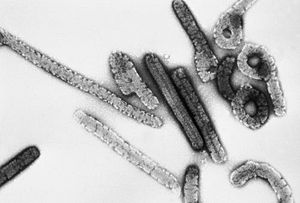Marburgvirus facts for kids
Quick facts for kids Marburgvirus |
|
|---|---|
 |
|
| Marburg virus structure, genome, and transmission electron micrograph | |
| Virus classification |
|
| (unranked): | Virus |
| Realm: | Riboviria |
| Kingdom: | Orthornavirae |
| Phylum: | Negarnaviricota |
| Class: | Monjiviricetes |
| Order: | Mononegavirales |
| Family: | Filoviridae |
| Genus: | Marburgvirus |
| Species and member viruses | |
|
|
The group of viruses known as Marburgvirus includes two main types: the Marburg virus (MARV) and the Ravn virus (RAVV). Both of these viruses can cause a very serious illness called Marburg virus disease in humans and some types of monkeys. This disease is a kind of viral hemorrhagic fever, which means it can cause bleeding inside the body.
Because these viruses are so dangerous, they are classified as "Select Agents." This means they need to be handled with extreme care in special labs called Biosafety Level 4 facilities. They are also listed as high-priority pathogens by health organizations around the world.
Contents
What is Marburgvirus?
The name Marburgvirus comes from the city of Marburg in West Germany. This is where the Marburg virus was first discovered. Even though the virus was named after the city, Dr. Ana Gligic was the first scientist to successfully isolate the virus in a lab in Belgrade.
Marburgvirus is a scientific name used to group certain viruses together. It belongs to a larger family of viruses called Filoviridae. Think of it like a family tree for viruses! Currently, there is only one specific type of virus within the Marburgvirus group, which is called Marburg marburgvirus. The actual viruses themselves are simply called marburgviruses.
How did the name Marburgvirus change?
For a while, all viruses in the Filoviridae family were just called Filovirus. But scientists later realized that marburgviruses and ebolaviruses (another group in the same family) were quite different. So, in 1998, they created a new group just for marburgviruses, calling it "Marburg-like viruses."
In 2002, the name was officially changed to Marburgvirus. Then, in 2010 and 2011, scientists made a few more small updates to how this group is defined.
How do scientists classify Marburgviruses?
Scientists have specific rules to decide if a virus belongs to the Marburgvirus group. These rules help them understand how different viruses are related. For example, a virus is considered a marburgvirus if:
- Its genetic material is very similar to the Marburg virus.
- It looks a certain way under a microscope, usually about 665 nanometers long.
- It doesn't react much with antibodies that fight ebolaviruses, showing they are different.
Understanding the Marburg marburgvirus Species
The specific type of virus called Marburg marburgvirus was first named Marburg virus in 1998. However, this caused confusion because it was also the name of one of the actual viruses.
To make things clearer, the name was changed in 2005 to Lake Viktoria marburgvirus. Then, in 2010, scientists suggested changing it again to Marburg marburgvirus, which was accepted in 2012.
So, Marburg marburgvirus is a scientific category that includes the two actual viruses: Marburg virus (MARV) and Ravn virus (RAVV). These are the "members" of this species. The name comes from the city of Marburg where the virus was first found.
See also
 In Spanish: Marburgvirus para niños
In Spanish: Marburgvirus para niños
Images for kids
-
Marburg virus structure, genome, and transmission electron micrograph


